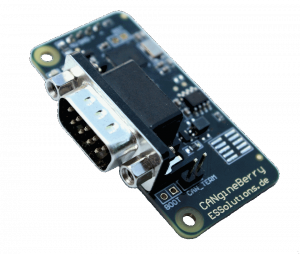Active CAN/CANopen “shield” CANgineBerry
 The new CANgineBerry is an active CAN interface with a Cortex-M0 microcontroller and various firmware options. At launch, two options are available: One for a CANopen Controller / Manager and one for a configurable CANopen slave device.
The new CANgineBerry is an active CAN interface with a Cortex-M0 microcontroller and various firmware options. At launch, two options are available: One for a CANopen Controller / Manager and one for a configurable CANopen slave device.
The CANopen Controller scans the network for connected slave devices within less than 50 ms after power-up, sets up process data handling, starts the network and continues monitoring it. Once the host that CANgineBerry is connected to is up and running as well, it can immediately start using the CANopen network and access any device.
The second firmware option is implementing a CANopen slave device which is fully configurable with node ID and with an Object Dictionary that the user creates with the provided CANopen Architect software (evaluation version is sufficient for this use).
The CANgineBerry’s host can be a Raspberry Pi®, another embedded computing systems or even a PC. The communication to the host system uses a regular serial channel (TTL-UART), so no special driver is required as UART support is typically part of all operating systems. The communication between host and CANgineBerry and the API is designed to serve the application. For example, heartbeats are automatically monitored but the host is only informed about changes in the heartbeat status (like “activated” or “lost”) but not about every individual heartbeat message.
This architecture of CANgineBerry addresses the shortcomings of many “CAN shields” that are passive, have no own intelligence and require the host computer to handle all CAN communication message by message. In worst case, a CAN system can have more than ten thousand individual messages per second. Sometimes the real-time requirements are below 10 ms for some responses which is not realistically achievable with a Linux or Windows® based host and a passive approach.
Summary of firmware options currently available or under development:
- CANopen self-configuring Controller / Manager
- CANopen slave device (configurable via EDS, Electronic Data Sheet)
- Lawicel CAN-RS232 protocol
- CANcrypt (secure CAN communication) for the above versions
- CiA 447 – automotive add-on electronics
- J1939 gateway
For more information about the CANgineBerry, current firmware options and availability, visit www.CANgineBerry.com
 Deutsch
Deutsch English
English
 Learn about our current product range for embedded systems
Learn about our current product range for embedded systems


 Embedded Networking with CAN and CANopen. Your technology guide for implementing CANopen devices.
Embedded Networking with CAN and CANopen. Your technology guide for implementing CANopen devices. Implementing scalable CAN security. Authentication and encryption for higher layer protocols, CAN and CAN-FD
Implementing scalable CAN security. Authentication and encryption for higher layer protocols, CAN and CAN-FD